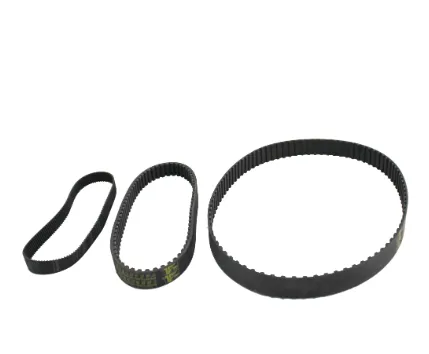Quality Standards for Synchronous Pulleys Products
In the realm of power transmission, synchronous belt pulley, synchronous pulley, and synchronous belts and pulleys play a crucial role in ensuring smooth and efficient operation of machinery. Shijiazhuang Anjie Electric Co., Ltd. is committed to providing high - quality synchronous pulley products that adhere to strict quality standards, enabling wholesalers to offer reliable solutions to their industrial clients.

Material Quality for Synchronous Belt Pulley
- High - Grade Material Selection: Shijiazhuang Anjie Electric Co., Ltd. uses high - grade materials for manufacturing synchronous belt pulley. Materials such as premium - grade aluminum alloy, steel, and engineering plastics are carefully selected based on the specific application requirements. Aluminum alloy pulleys offer a lightweight yet durable option, reducing inertia in high - speed applications. Steel pulleys, on the other hand, are ideal for heavy - duty scenarios where high strength and load - bearing capacity are needed. The use of quality materials ensures that the synchronous belt pulley can withstand the rigors of continuous operation and various working conditions.
- Material Testing and Certification:Before production, all materials undergo strict testing to ensure they meet international and industry - recognized quality standards. These tests include checks for material composition, mechanical properties such as tensile strength, hardness, and fatigue resistance. Additionally, materials may be certified by relevant authorities, providing wholesalers with the confidence to market products that are of reliable quality. This commitment to material quality is the foundation for the overall performance and longevity of the synchronous belt pulley.
Precision Manufacturing of Synchronous Pulley
- Advanced Manufacturing Processes: The company employs advanced manufacturing processes to produce synchronous pulleywith high precision. CNC machining technology is used to ensure accurate tooth profiles, diameters, and other critical dimensions. This precision is essential for proper meshing with synchronous belts, minimizing slippage and ensuring efficient power transmission. The use of state - of - the - art equipment and manufacturing techniques allows for consistent production quality across a wide range of pulley sizes and specifications.
- Stringent Quality Control Checks: At every stage of the manufacturing process, stringent quality control checks are carried out for synchronous pulley. From the initial machining operations to the final assembly, each pulley is inspected for dimensional accuracy, surface finish, and any potential defects. Non - destructive testing methods may also be employed to detect internal flaws that could affect the pulley's performance. These quality control measures ensure that only products that meet the highest standards are delivered to wholesalers.
Compatibility and Performance of Synchronous Belts and Pulleys
- Optimal Belt - Pulley Matching:Shijiazhuang Anjie Electric Co., Ltd. focuses on ensuring optimal compatibility between synchronous belts and pulleys. The design of the pulleys takes into account factors such as belt pitch, width, and tooth shape to ensure a perfect fit. This compatibility is crucial for smooth operation, reducing noise, vibration, and wear. By providing well - matched synchronous belts and pulleys, wholesalers can offer solutions that enhance the overall performance and reliability of their clients' machinery.
- Performance Testing:The synchronous belts and pulleys are subjected to rigorous performance testing. These tests simulate real - world operating conditions, including different loads, speeds, and environmental factors. Performance metrics such as power transmission efficiency, belt life, and pulley durability are evaluated. The results of these tests are used to continuously improve product design and manufacturing processes, ensuring that the synchronous belts and pulleys can perform reliably in a variety of industrial applications.
Synchronous Pulley FAQS
What materials are used for synchronous belt pulley?
Shijiazhuang Anjie Electric Co., Ltd. uses materials such as premium - grade aluminum alloy, steel, and engineering plastics for synchronous belt pulley. The choice of material depends on the specific application requirements, with aluminum alloy for lightweight and high - speed scenarios and steel for heavy - duty applications.
How is the precision of synchronous pulley ensured?
The precision of synchronous pulley is ensured through advanced manufacturing processes like CNC machining, which guarantees accurate tooth profiles and dimensions. Additionally, stringent quality control checks are performed at every stage of production, including dimensional inspections and non - destructive testing for internal flaws.
Can synchronous belts and pulleys be customized for specific applications?
Yes, synchronous belts and pulleys can be customized. Special specification belts can be made according to the buyer's provided drawing or sample. Also, the width of the belt can be adjusted as per the buyer's needs, ensuring a perfect fit for specific industrial applications.
How are the quality standards of synchronous belt pulley maintained?
Quality standards for synchronous belt pulley are maintained through a comprehensive quality assurance system. This system involves strict material testing before production, advanced manufacturing processes, and continuous quality control checks during production. Regular audits and reviews also ensure compliance with international and industry - recognized standards.
What kind of performance testing do synchronous belts and pulleys undergo?
Synchronous belts and pulleys undergo rigorous performance testing that simulates real - world operating conditions, including different loads, speeds, and environmental factors. Metrics such as power transmission efficiency, belt life, and pulley durability are evaluated to ensure reliable performance in various industrial applications.








